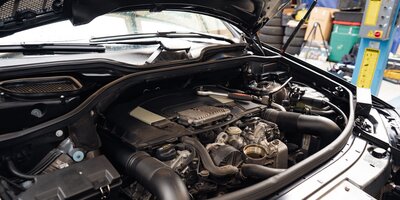Car leaking coolant: causes, symptoms and best solutions
Driving is a blend of exhilaration and convenience, but sometimes, your trusty car can hit a snag. One of the most frustrating issues is a coolant leak.
Coolant, often referred to as the versatile 'antifreeze,' assumes the uncelebrated role of an automotive guardian, ensuring your engine's harmonious operation. This unassuming fluid stands as a bulwark against the scorching summer heat and the bone-chilling cold of winter. Nevertheless, when the vigilance of antifreeze wanes, and it embarks on an unauthorized journey beyond its confines, ominous troubles come into view.
This article explores the causes, symptoms, and solutions for car antifreeze seepages. We’ll uncover the culprits, recognize red flags, and guide you towards the best fixes. Whether you’re a gearhead or a newbie, you’ll be well-prepared to tackle this common car woe and ensure your ride remains dependable.
What is an antifreeze leak
A frost inhibitor seeping is an unwelcome issue that occurs when the heat transfer fluid escapes from your car's thermal regulation system. This system plays a vital role in maintaining your engine's temperature, ensuring it doesn't become excessively hot or cold. Radiator fluid is the lifeblood that keeps this system running smoothly.
When seepage occurs, it signals a critical escape of this vital fluid from its designated routes, a phenomenon attributed to a myriad of factors. Such leakage may manifest anywhere within the intricate web of the cooling system, encompassing the radiator, hoses, and even permeating the inner sanctum of the engine.
Frost inhibitor leakages can vary in severity, from minor seepage to a torrential flow. Irrespective of their size, they are a cause for concern because they disrupt the efficiency of the temperature control system. This can potentially lead to issues such as engine overheating, reduced performance, and the prospect of costly repairs if left unaddressed.
In the upcoming sections of this article, we will delve into the common causes behind leaking antifreeze, the telltale signs that your car may be experiencing one, and the recommended steps to take when you suspect a heat transfer fluid seeping in your vehicle. Join us as we demystify this automotive inconvenience and present effective solutions.
How to know if coolant is leaking
Detecting a heat transfer fluid seepage in your car is crucial to preventing potential engine damage and costly repairs.
Identifying frost inhibitor seepages:
1. Puddles of colorful liquid beneath your car.
2. Sweet odor in or around your vehicle.
3. Consistently low antifreeze levels.
These signs can help you quickly identify a potential heat transfer fluid seepage in your vehicle. In the following sections, we will delve deeper into the symptoms and solutions associated with heat transfer fluid seepages.

What causes coolant to leak
«Why is my car leaking coolant?" is an alarming question that often troubles vehicle owners. Understanding the causes behind radiator fluid seepages is essential for addressing this issue effectively.
Worn or damaged hoses
Rubber hoses in the thermal regulation system can deteriorate over time, leading to cracks or holes that allow frost inhibitor to escape.
Radiator problems
Corrosion, rust, or physical damage to the radiator can create openings for radiator fluid to leak.
Gasket failures
Deficiencies in pivotal gaskets such as the head gasket or intake manifold gasket can lead to the migration of radiator liquid into the engine's internal chambers or external regions.
These are the primary culprits behind heat transfer fluid seepings in most vehicles. Identifying which of these issues is causing the seepage is crucial for effective repairs. In the following sections, we will explore how to recognize the symptoms of a coolant leak and provide guidance on resolving these problems. Stay tuned for valuable insights into managing this common automotive concern.
Where can coolant leak from
Frost inhibitor seepings can originate from various locations within your vehicle’s cooling system. Understanding where these seepings occur is vital for diagnosing and addressing the issue. Here are the key areas where heat transfer potentially seeps from:
1. Hoses: rubber hoses connecting various parts of the cooling system.
2. Radiator: the main cooling component develops leaks due to damage or corrosion.
3. Gaskets: critical gaskets like the head gasket or intake manifold gasket can fail.
4. Water pump: a malfunctioning water pump leads to radiator fluid seepings.
5. Radiator cap: a faulty cap causes pressure issues and seepages.
6. Expansion tanks: these tanks or reservoirs develop seepings.
7. Thermostat housing: the housing around the thermostat can be a potential seepage point.
8. Heater core: seepings in the heater core affects the interior of the vehicle.
9. Freeze plugs: corrosion or damage to engine block freeze plugs result in seepage.
10. Accidental damage: damage from road debris or accidents causes seeping.

Coolant leak symptoms and signs
Puddles under the car
Noticeable puddles of brightly colored radiator fluid under your parked car are a clear indicator of a radiator fluid seeping.
Engine overheating
If your engine consistently runs hotter than normal or frequently overheats, it may be due to a radiator fluid seeping reducing the system's efficiency.
Sweet odor
A distinct sweet smell, often like maple syrup, inside or around your car signifies an antifreeze seepage.
Low coolant level
You wonder: “Why is my car using so much coolant?”. Check the heat transfer fluid reservoir or radiator when the motor is cool. A consistently dropping level, even after topping off, indicates a seepage.
White smoke from exhaust
White smoke, with a sweet smell, coming from the exhaust may be a sign of antifreeze burning in the engine due to a seeping.
Visible leaks
Inspect hoses, connections, radiator, and engine for visible moisture or wet spots, indicating a seeping.
Discolored engine oil
A radiator fluid seeping causes motor oil to appear milky on the dipstick.
Rising Temperature Gauge
Consistently high engine temperature readings are a sign of insufficient antifreeze due to a seeping.
Unusual Noises
Listen for bubbling or hissing sounds from the motor or radiator area, which may indicate an antifreeze seepage.
Dashboard Warning Light
Some vehicles have a specific warning light for antifreeze issues. If it illuminates, it's a clear sign of a heat transfer fluid problem.
Recognizing these antifreeze leak symptoms promptly helps you identify a antifreeze seeping and address it before it leads to further engine complications. In the following sections, we will explore effective solutions for dealing with coolant leaks. Stay tuned for valuable insights into managing this common automotive concern.
How dangerous is an antifreeze leak?
Why are coolant leaks dangerous:
1. Antifreeze regulates your engine’s temperature. A seepage causes the engine to overheat, potentially leading to severe damage or even motor failure.
2. As the thermal regulation system loses heat transfer fluid, your engine’s performance may suffer. It leads to decreased power, reduced fuel efficiency, and poor overall drivability.
3. Ignoring a radiator fluid seepage results in costly repairs, including motor damage, which might require a complete overhaul or replacement.
4. Antifreeze is toxic to animals and harmful to the environment. A seeping can have adverse effects if not cleaned up promptly and responsibly.
5. Antifreeze on the road can create slippery conditions, increasing the risk of accidents.
6. If the seeping affects the heater core, it damages the interior of your vehicle, causing discomfort and expensive repairs.
In summary, cooling leaks can be dangerous because it leads to safety hazards, environmental damage, and costly repairs. Detecting and addressing coolant leaks promptly is essential to mitigate these risks and ensure your vehicle’s safe and reliable operation. In the next sections, we will explore effective solutions for dealing with heat transfer fluid seepings and preventing their recurrence.

How to fix antifreeze leakage
1. Identify the origin: determine the source of the leak, which could be hoses, the heat exchanger, gaskets, or other components.
2. Prioritize safety: park safely on level ground, ensure the engine has cooled, and turn off the ignition.
3. Secure hose clamps: if hoses are the culprit, tighten or replace hose fasteners.
4. Replace damaged hoses: for hoses with cracks or wear, substitute them with compatible replacements.
5. Utilize heat exchanger sealant: apply radiator sealant for minor heat transfer fluid seepings, but replace the heat exchanger for more extensive damage.
6. Address faulty gaskets: repair faulty gaskets, such as the head gasket, possibly necessitating professional intervention.
7. Consider water pump replacement: contemplating the replacement of a leaking water pump is often prudent.
8. Professional expertise: engage certified mechanics for intricate or challenging seepage issues.
9. System flush and refill: after repairs, thoroughly flush the system and refill it with the correct coolant mixture. BIZOL Coolant G12+ is a modern long-life antifreeze used for protection of the car cooling system from freezing and overheating. Recommended for all vehicles that require an antifreeze free from silicate, nitrite, amine and phosphate.
Exercise caution when handling antifreeze, and adhere to proper disposal procedures for used radiator liquid. If uncertain about repair procedures or if you observe signs of a coolant leak, seek advice from professional auto mechanics to ensure the effective operation of your vehicle’s cooling system.

How to prevent coolant leaks
Key steps to prevent heat transfer liquid seepages:
1. Regular maintenance: follow your vehicle manufacturer's recommended maintenance schedule. Regular check-ups help to identify and address potential issues before they become seepages.
2. Replace hose clamps: hose clamps sometimes weaken over time. Replace them if they become loose or damaged to ensure a secure connection.
3. Monitor radiator condition: keep an eye on your radiator to notice signs of corrosion, rust, or damage.
4. Check gaskets: be vigilant about the condition of gaskets, particularly the head gasket.
5. Inspect water pump.
6. Use quality coolant: BIZOL coolant products protect against corrosion, care for the entire thermal regulation system, improve engine protection.
7. Avoid overheating: prevent engine overheating by maintaining a healthy cooling system, ensuring proper fan operation, and addressing issues promptly.
8. Avoid quick temperature changes: extreme temperature fluctuations can stress the cooling system. Allow your engine to warm up gradually in cold weather.
9. Be cautious about using coolant additives unless recommended by the vehicle manufacturer. Some additives may harm gaskets and seals.
10. Periodically pressure-test the cooling system to identify any weaknesses or potential seepages.
11. Check for signs of leakage or dampness around the heater core, especially if you notice a sweet antifreeze odor inside the vehicle.
12. Ensure the cooling liquid reservoir or heat exchanger always maintains the correct level.
By following these preventive measures and conducting regular inspections, you can significantly reduce the risk of coolant leakage and extend the life of your vehicle's cooling system.
Always handle radiator liquid safely and dispose of it responsibly. Incorporating preventive measures and quick responses to heat transfer fluid seepages ensures a trouble-free driving experience while preserving your vehicle's cooling system.
You might also like

The modern marvel of an internal combustion motor powers our vehicles, providing the strength and reliability we rely on for daily transportation. However, just like anything else subjected to constant use, motorized units experience wear and tear over time. Component deterioration can significantly impact performance and longevity. In this article, we will delve into the intricacies of engine wear meaning, explore the various causes behind it, provide actionable tips to reduce and prevent it. Furthermore, we will look at how specialized engine oils, such as BIZOL, play a crucial role in safeguarding your engine’s health. Let’s begin by understanding what engine wear is and the factors that contribute to it.

The melodious purr of a motor, the velvety transition of cog-wheel, and the elegant voyage along the expansive highway — these are the unmistakable characteristics of a meticulously calibrated self-shifting gearbox system. But what transpires when the motorized ensemble falters, the cogs gnash, and the voyage veers into an unforeseen tempest? Get into the realm of automatic transmission problems, a domain where automotive aficionados and everyday motorists alike encounter the enigmatic intricacies of this complex system.

Driving is a blend of exhilaration and convenience, but sometimes, your trusty car can hit a snag. One of the most frustrating issues is a coolant leak.
Coolant, often referred to as the versatile 'antifreeze,' assumes the uncelebrated role of an automotive guardian, ensuring your engine's harmonious operation. This unassuming fluid stands as a bulwark against the scorching summer heat and the bone-chilling cold of winter. Nevertheless, when the vigilance of antifreeze wanes, and it embarks on an unauthorized journey beyond its confines, ominous troubles come into view.

